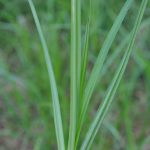Nutsedge: Causes and How We Can Treat It

As a homeowner with a maintained lawn, you may have heard of something called Nutsedge. Sometimes referred to as “sedgegrass,” “nutgrass,” or “watergrass,” this undesirable plant that tends to grow in wet areas is troublesome to many home lawns. Also, nutsedge is not a grass or a broadleaf weed, it is in the sedge family. This perennial plant grows from nutlets and rhizomes in the soil, that can remain there for many seasons. Throughout this blog we will dive deeper into identifying and treating the unsightly plant.
How to Identify Nutsedge
Nutsedge is easy to identify in a well-maintained lawn. In the summer months you might notice a small area of tall lime-green colored grass that is standing out amongst your lawn, this is typically nutsedge. One way to be sure is to look closely at the plant; the plant has a triangular base, and the nutsedge blade has a pronounced mid rib running down the middle.
What to Do If I have Nutsedge
- Nutsedge is most problematic in lawns that have poor drainage or stay wet too long. This could be from overwatering with a sprinkler system, a lot of rain, or a combination of both. The best way to minimize nutsedge is to grow and maintain dense and healthy turf to outcompete nutsedge for space, food, and moisture.Low spots in the lawn that hold water also contribute to the proliferation of nutsedge. If you have drainage issues where water is pooling and is not running off or percolating into the soil, you may need to install drains or regrade the soil on the property. This will help move the water along, so it doesn’t sit causing the soil to remain wet for long periods of time. Additionally, you may want to rethink your watering schedule and timing in those zones, if you don’t want to regrade or add drainage.
For information about cultural practices that may help with nutsedge control, you can read our blogs about each topic.
Should I pull Nutsedge out by hand?
We do not recommend pulling nutsedge out by hand. The reason being, when you pull nutsedge out by hand, you are only removing the blade above the soil. The nutlets and rhizomes are still present in the soil. Without killing the nutlets and rhizomes the nutsedge plants will continue to regrow in the same spot.
Chemical Control Option
At this point there are no preventatives for nutsedge currently on the market, so this only leaves post emergent control options. It’s important to know that traditional broadleaf weed and/or crabgrass controls do not kill or prevent nutsedge. Why? Nutsedge is not a broadleaf weed or grass, it’s considered a sedge. For nutsedge control a specialized product specifically or nutsedge provides adequate control when applied properly. Also, you may need more than one treatment to control the nutsedge present in the lawn. We recommend contacting a professional lawn care company to treat the nutsedge.
Homeowners can also treat nutsedge. We recommend if you are going to treat the nutsedge yourself to follow the label instructions closely to get the proper control. Finally, give the product time to work before you apply more.
We do not recommend using a non-selective herbicide (i.e. Round-Up) to control nutsedge. Products like this will damage the turf surrounding the nutsedge as well! This would lead to larger damaged areas of turf that will need to be seeded to establish grass again; the idea is to kill the nutsedge, not the desired grass around it.
Conclusion
As the temperatures decrease with the onset of Fall, nutsedge will naturally start to die out on its own. It is important to remember that although the nutsedge blade is gone the nutlets will still be in the soil and will not die from the colder weather. Nutlets will produce new plants the next season and the nutsedge cycle will start over again, if left untreated.
Treating the nutsedge each year with a chemical control helps to reduce the amount of nutsedge present in the lawn from year to year. Although you may never eradicate the plant from your lawn entirely, a reduced number is more manageable than leaving it untreated.
If you are in our service area, and have questions about nutsedge control, request a free estimate online or give our office a call at 908-281-7888.







